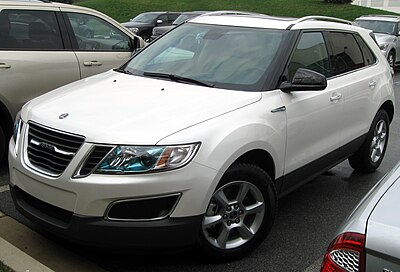
Search
Saab 9-4X

The Saab 9-4X is a mid-size luxury crossover SUV that was introduced at the 2010 LA Auto Show. It is based on the all-wheel-drive GM Theta Premium platform, which also forms the basis for the Cadillac SRX. Production of the 9-4X began in 2011, at General Motors' Ramos Arizpe Assembly in Mexico, but halted before the end of that year as a result of the bankruptcy of Saab, leaving a total of 814 assembled.
Design
The 9-4X took shape once the Saab 9-6X project was canceled, after the divestment by General Motors of its holding in Subaru. The 9-4X replaced the larger Chevrolet TrailBlazer–based Saab 9-7X built in the U.S. that was discontinued in December 2008. The concept of the 9-4X made its debut at the 2008 North American International Auto Show.
The production car is almost identical to the concept of 2008 on the exterior and similar to the second generation Saab 9-5 on the inside. The mechanical parts such as the engine, transmission, and other mechanical systems are all GM with exterior trim and lighting specific to the 9-4X.
As such, a review noted specific Saab identity and "charm" as well as its flaws that included excess weight and lackluster fuel economy, but "it is easily as compelling as the Cadillac SRX on which it is based." The car began selling as a 2011 model year in June in the United States and in August elsewhere. A 2012 Aero version was reviewed by Road & Track in April 2011.
Production
General Motors manufactured the 9-4X and the closely related Cadillac SRX at the Ramos Arizpe, Mexico, assembly plant. The company announced that the 9-4X would go on sale in 2010 to bolster Saab's position in the United States, the brand's largest marketplace.
The 9-4X was the only Saab built in Mexico.
The first unit was produced in February 2011, and it was displayed at Saab's Museum in Sweden. In November 2011, GM announced that production of the 9-4X would end, because General Motors was unwilling to provide a modern chassis and engine to a Chinese buyer that was a potential competitor to GM in China.
In February 2010, GM sold Saab Automobile AB to the Dutch automobile manufacturer Spyker Cars N.V.
According to information at the Saab Museum in Trollhättan, Sweden, 814 9-4X units were produced. However, an unofficial Saab 9-4X production report noted that 673 production 9-4X units along with approximately 130 test units were built, for a grand total of 803 9-4X units.
Specifications
The 9-4X was available with a choice of two petrol V6 engines: a 3.0L producing 265 bhp (198 kW; 269 PS) and 223 lb⋅ft (302 N⋅m) torque, or a 2.8L turbo with 300 bhp (224 kW; 304 PS) and 295 lb⋅ft (400 N⋅m). The 2.8T engine is mated to an Aisin-Warner six speed automatic transmission, operable in manumatic mode via paddle shifters. A diesel engine for the European market was discussed, but never offered.
References
External links
- Saab 9-4X forum, tutorials, and media archive on SaabWorld
Text submitted to CC-BY-SA license. Source: Saab 9-4X by Wikipedia (Historical)
Owlapps.net - since 2012 - Les chouettes applications du hibou



